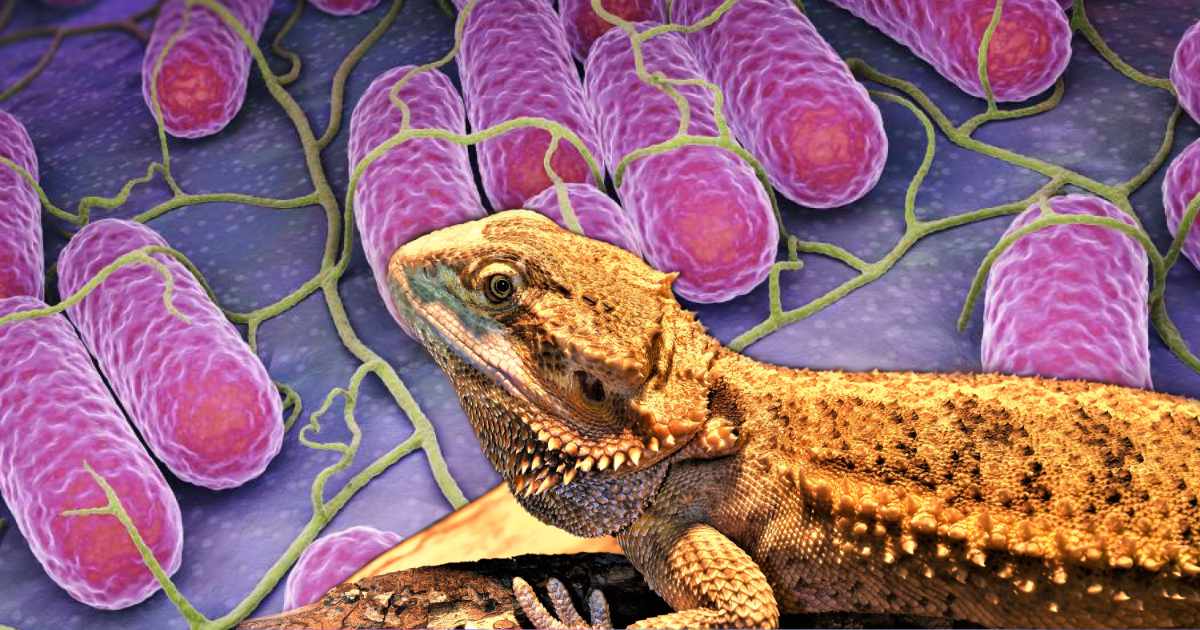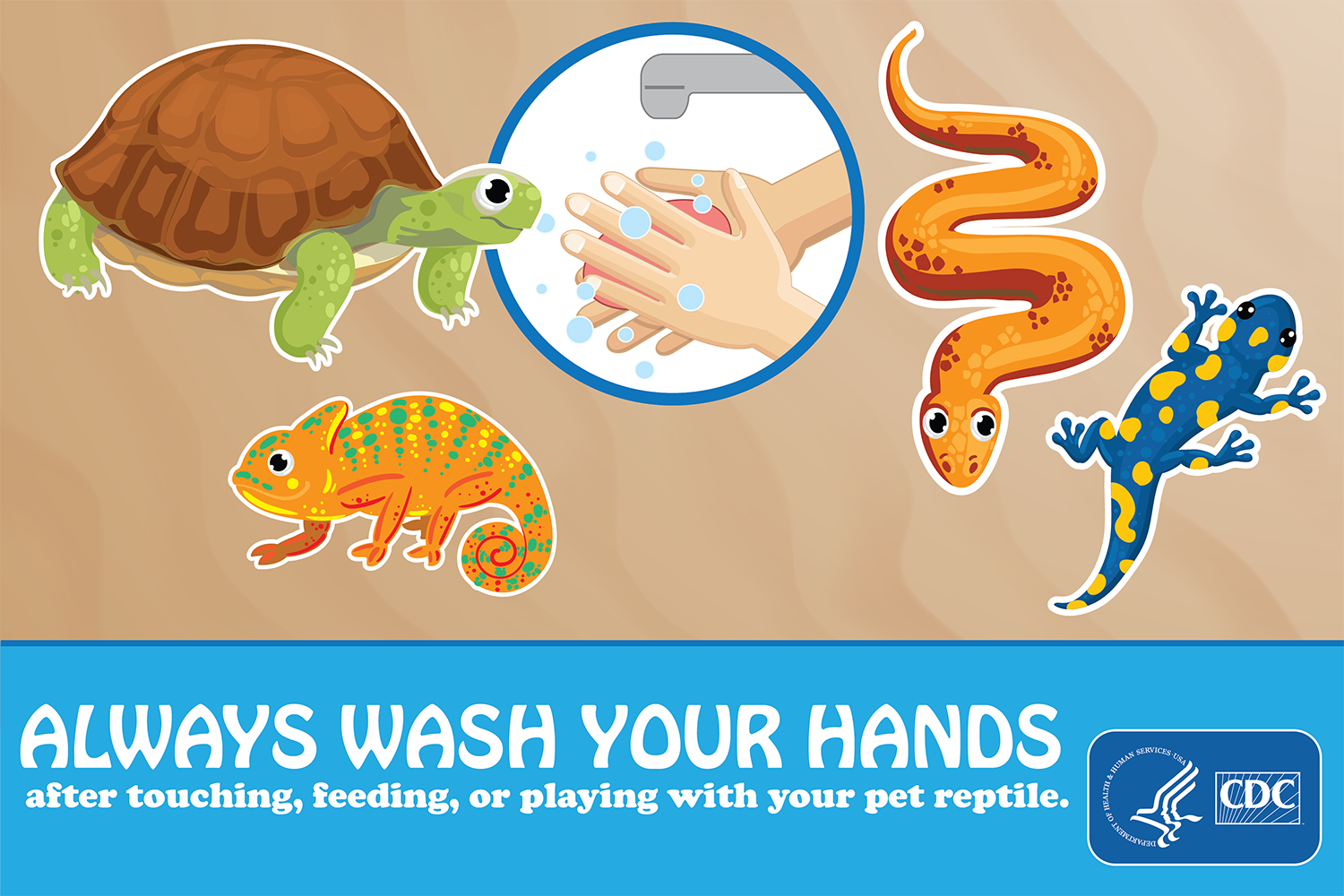Bearded Dragon Salmonella
In this post we learn that bearded dragons do carry salmonella but with some simple precautions your risk is extremely small.

Last Updated: January 14th, 2022
By: Steve
Table of Contents
The topic of bearded dragon salmonella has been in the news recently with a report from the CDC on 11th January 2022 regarding an outbreak of salmonella linked to bearded dragons[1]. The terminology used appears at this stage at least to be a little misleading in the context of an ‘outbreak’. The term outbreak implies that a single source started an event and then passed that on to a number of other people by infection. But this doesn’t appear to be what’s happened here, with (at time of writing) patients appearing in 25 states of the USA, and only 44 illnesses presently detected over the course of a whole year.
Describing this as an ‘outbreak’ is alarmist and extreme. We’ll look at why throughout this post.
It is possible that a single source of this strain exists and the CDC are engaging in genomic sequencing to try to trace the source of the infection. But on current evidence it’s a bit disingenious to be blaming bearded dragons for this. Possibly, and perhaps more likely, would be a single source of infected live-foods which the bearded dragons have eaten could explain the situation, as these could be shipped across the 25 affected states.
Further in this post we’ll look at the annual level of reptile acquired salmonella infections and notice that, presently at least, the amount of infections attributed in this ‘outbreak’ seems fairly consistent with normal numbers.
The CDC, at the time of writing, appears very light on detail about the original source of the infections however. At present they’re monitoring the situation and have given some good guidance on how to avoid contracting salmonella from your bearded dragon. We’ll look at this in the sections below.
Do Bearded Dragons Have Salmonella?
Yes, some bearded dragons can carry salmonella. It’s fairly well known that bearded dragons (and other reptiles) can carry salmonella bacteria. They can ingest it from their live-foods, or indeed even the vegetable foods potentially.
A literature review study from 2017 suggests that between 48% to 83% of captive lizards carry salmonella bacteria, across various countries – though the cause is uncertain since only around 25% of wild lizards harbour the bacteria[2]. The literature review states that in the USA 6% of all salmonella cases are caused as a result of contact with a reptile accounting for around 74,000 cases of reptile acquired salmonella per year.
According to the American Veterinary Medical Association, approximately 6 million people owned reptiles in 2017-2018[3]. At the same time the United States Population was approx. 326 million[4]. This equates to approx. 2% of the US population keeping reptiles.
If the study numbers above are correct, this means that 2% of the population account for 6% of the overall salmonella cases in the USA. This does suggest you are more likely to catch salmonella if you own a reptile.
With that said, it is exceedingly easy to avoid catching salmonella from reptiles with some simple hand hygiene. We’ll go into more detail about this below
How To Know If Your Bearded Dragon Has Salmonella
Given the statistics given above there’s a pretty good chance your bearded dragon does have salmonella. It’s, at best, a 50/50 chance. At worst, it’s 80% likely they do. The likelihood of the bearded dragon displaying any significant symptoms that you would notice is vanishingly small.
It’s therefore far better to simply assume that your bearded dragon does have salmonella and behave accordingly.
How To Avoid Bearded Dragon Salmonella

It’s important to remember that salmonellosis (the illness caused by salmonella bacteria) is generally acquired through ingesting the bacteria. A study from 2006[5] suggests that salmonellosis is transmissible by air as well, although the study method may not mimic real world results, and gives little evidence for this in the case of bearded dragon enclosures. We believe it’s safe to assume that almost all salmonellosis cases involving reptiles are transmitted through the faecal-oral route. That is to say, humans handling items (or the dragon itself) when it is contaminated with bearded dragon poop – and then touching other things involved in food preparation which then leads to eating contaminated food as a result. Or potentially simply putting contaminated fingers straight into ones mouth after handling.
Good bearded dragon husbandry can help keep the bacteria levels under control in the reptile enclosure itself – making sure you have the right temperatures in your tank is an important way to do this, as well as the high levels of UVB that bearded dragons require.
Keeping their tank clean and disinfected regularly will help keep the bacteria under control and help reduce the risk of you catching it. Cleaning up their poop quickly after they’ve deposited it is also very important. This is important in any case for the general wellbeing of your bearded dragon, to reduce the risk of other parasites overwhelming their immune systems too.
Most importantly – your hand hygiene is the single most effective way of ensuring any salmonella bacteria your bearded dragon might be harboring do not get transferred to you. This cannot be stressed enough. Any time you have contact with your bearded dragon, or items in their enclosure – and especially after cleaning up their poop – wash your hands properly.
With the recent Covid-19 pandemic we should all know how to wash our hands properly. The CDC have produced a leaflet which can help you stay safe from salmonella around your bearded dragon here.
How Easy Is It To Get Salmonella From Reptiles
This depends on how rigorous your hand hygiene regime is. If you practice good hand hygiene it will be very difficult for you to get salmonella from reptiles. We would of course like to add that you shouldn’t be kissing your reptile either, as this could potentially transfer salmonella bacteria straight to your mouth, since you don’t know what they have been in contact with prior.
If you kiss your reptile regularly, or don’t practice good hand hygiene it is extremely easy to get salmonella from them. You may have no symptoms, or you may get a fever, diarrhea and vomiting and be rather unwell. In most cases, for healthy people, salmonella doesn’t require hospital and will resolve on its own. But you will want to keep your fluids up and definitely seek professional medical advice appropriate to your specific situation.
Summary
Bearded dragons can give you salmonella if you don’t keep them, their enclosures and your hands clean. Statistics seem to suggest that you’re still far more likely to be injured in a car crash (3 million people per year are injured in car crashes in the USA[6]) than you are to contract salmonella from your bearded dragon and it’s considerably easier to reduce the risk to almost nothing.
We feel that the CDC advice to not own a bearded dragon if you are over 65 is extreme. With proper hygiene measures there’s, in our opinion, no reason not to. Just practice good hygiene. We do somewhat agree with the CDC that children under 5 should not be allowed to handle reptiles, particularly unsupervised, because children are extremely prone to touching things then shoving their fingers in their noses or mouths. This is liable to lead to an infection at some point in time.
It’s our belief that the current terminology of ‘outbreak’ and ‘do not have lizards if you are in certain demographics’ is overblown and disproportionate to the risk. If you practice good hygiene your risk is still minimal. Get into the habit of good hygiene (particularly hands) and you’ve little to worry about from salmonella from your lizard.
This is no different to any other animal you may keep as a pet.
If you’ve found this post useful please feel free to share it using the buttons below. If you would like to ask us anything, or let us know your opinion please feel free to leave a comment below.
Thanks for reading – keep washing those hands and don’t sweat about salmonella!
References
1: Centers For Disease Control and Prevention (2022). Salmonella Outbreak Linked To Pet Bearded Dragons. Fetched 14 January 2022 from https://www.cdc.gov/salmonella/uganda-01-22/index.html
2: Whiley H., Gardner M. G., Ross K. (2017). Pathogens. A Review Of Salmonella and Squamates (Lizards, Snakes, Amphibians): Implications for Public Health. Sep 2017: 6(3) 38. doi: 10.3390/pathogens6030038. Fetched 14 January 2022 from https://www.ncbi.nlm.nih.gov/pmc/articles/PMC5617995/
3: American Veterinary Medical Association. U.S. Pet Ownership Statistics. Fetched 14 January 2022 from https://www.avma.org/resources-tools/reports-statistics/us-pet-ownership-statistics
4: Worldometer. United States Population. Fetched on January 14 2022 from https://www.worldometers.info/world-population/us-population/
5: Oliveira C. J. B., Carvalho L. F. O. S., Garcia T. B. (2006). Epidemiology and Infection. Experimental Airborne Transmission of Salmonella Agona and Salmonella Typhimurium in weaned pigs. Feb 2006; 134(1): 199-209. doi: https://dx.doi.org/10.1017%2FS0950268805004668
6: Driver Knowledge. Car Accident Statistics In The U.S. Fetched 14 January 2022 from https://www.driverknowledge.com/car-accident-statistics/
